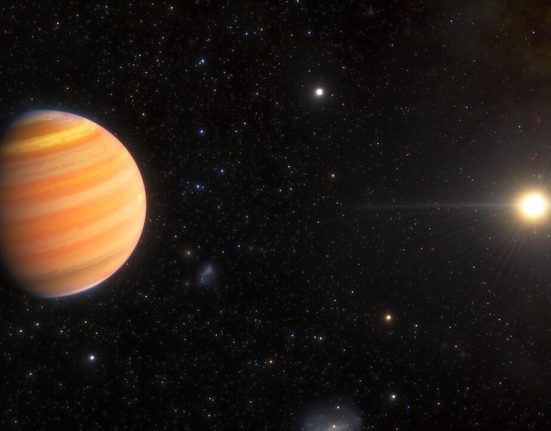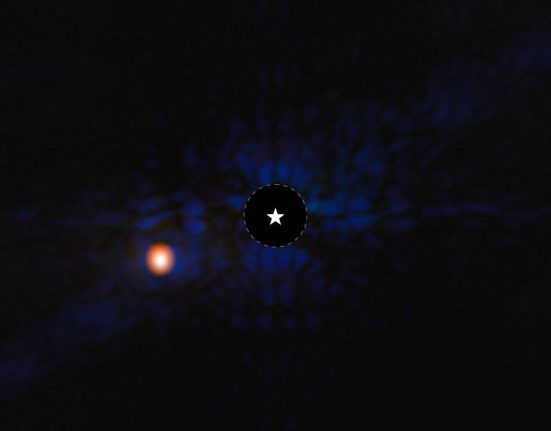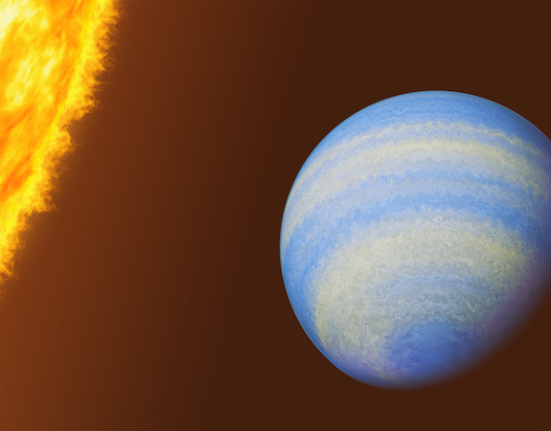
B. Gougeon/University of Montreal
Imagine a habitable world, with a single temperate ocean surrounded by ice on all sides. This “eyeball planet” may sound like something out of science fiction, but it’s entirely possible, and astronomers think they may have found such a world at LHS 1140b.
Located just 49 light-years away in the constellation Cetus, LHS 1140b is one of the closest discovered planets found within the orbit of its star. habitable zone — the region where a planet could retain liquid water.
In an article published in Letters from the Astrophysics magazineResearchers analyzed atmospheric data from the James Webb Space Telescope's slitless spectrograph and near-infrared imager and found hints that LHS 1140b may harbor a nitrogen-rich atmosphere.
Added to the team Previously published conclusions While this world could be made of water ice, traces of nitrogen-based air would allow for oceans to exist on the planet's surface. It's also possible, because LHS 1140b always faces the same side of its star., that the world could be largely frozen, with a temperate ocean only on its dayside, making it appear like an “eyeball planet.”
So far, however, the team only has clues about the composition of the atmosphere: the researchers could not rule out that the planet might have no atmosphere at all, making it a world of barren rock or ice.
“What I find most significant about this result is that there is an indication that LHS 1140b could “There is no atmosphere at all,” says Jason Dittmann (University of Florida), co-discoverer of LHS 1140b who was not involved in this study.
LHS 1140b is the first rocky exoplanet to show signs of an atmosphere, and while the atmospheric results of the study are tentative, LHS 1140b is certainly a promising habitable candidate to keep an eye on.
Clues of an atmosphere
With a radius about 1.7 times that of Earth, LHS 1140b is a rare find. While most super-Earths are less than 1.5 times the radius of Earth, and most mini-Neptunes have radii between 2 and 3 times that of Earth, LHS 1140b is one of the few planets found so far that lies in between, in the so-called “radius valley.”
Based on its mass and radius, the team had previously found that LHS 1140b's average density indicates that it is either a mini-Neptune wrapped in a thin hydrogen envelope or a “water world” with water making up as much as one-fifth of its composition (by comparison, our own planet's mass is just 0.02% water). Such a world might have a thin envelope of nitrogen or carbon dioxide.
To determine which option best describes LHS 1140b, astronomers used the Webb telescope to measure the planet's atmosphere. As LHS 1140b makes its 25-day transit in front of its host star, light from the star passes through the planet's atmosphere (if it has one) like a flashlight shining through fog. Molecules in the planet's upper atmosphere will absorb the star's light at different wavelengths, leaving imprints in the stellar spectrum.
The astronomers found no evidence of atmospheric hydrogen, supporting previous observations taken with other space telescopes. The researchers therefore reject the hypothesis that this is a cloudless, hydrogen-rich mini-Neptune. The team concludes that the planet is instead a water world; traces of nitrogen in LHS 1140b's atmosphere are consistent with this conclusion.
However, the study also found that Webb's spectrum, which is mostly flat and featureless, might not allow for the presence of an atmosphere, especially considering the star's own activity. Hot, active regions of the host star, called faculae It can be added to the light shining through the planet's atmosphere. “A fit with only starbursts (and no planetary atmosphere) provided a reasonable fit (to the data),” says team member Ryan MacDonald (University of Michigan).
However, a model that combined star faculae and a nitrogen-rich atmosphere matched the Webb data better. Other factors also support the existence of an atmosphere for LHS 1140b: it is more massive than Earth, so it has a strong surface gravity that can better hold on to the atmosphere. Its host star is also less active than others (such as TRAPPIST-1, whose radiation could have stripped the atmospheres of its rocky planets).
To make the most of Webb's data, the team also used global climate models Simulate interactions between the different possible components of a planet's climate, including not only its atmosphere, but also any land surface, ocean, and sea ice. These simulations can help assess the likelihood of different atmospheres existing, as well as the possibility of liquid oceans existing.
“In fact, we have 3D global climate simulations of the planet that predict there will be a liquid ocean and clouds only in a small region,” Cadieux said. “LHS 1140 b is the most credible ‘eyeball planet’ candidate we know of.”
Next steps
The team hopes to continue using the Webb telescope to determine the planet's surface features and to look deeper into its atmosphere. It will likely take years to obtain all the necessary data.
“If firmly confirmed by additional observations, our tentative result for a nitrogen-rich atmosphere at LHS 1140b would be the first such detection,” says Cadieux. Currently, the only planets in the habitable zone of their host star with a definitive detection of an atmosphere are Earth and Mars.
Although Webb's spectrum of LHS 1140b revealed only hints of nitrogen, Dittman says those hints warrant more time with the telescope. “More data could either confirm it or could throw the result out the window,” he says. “Right now, it's an exciting time for exoplanets!”












Leave feedback about this